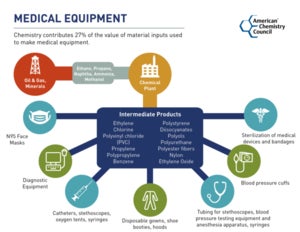Today marks one year since the World Health Organization declared COVID-19 a pandemic. Two days later, on March 13th President Trump would declare it a national emergency. Here in the U.S., more than half a million people have lost their lives; and many millions more, their livelihood. Yes, it has been a painful year.
But even in those darkest hours, how could we not see and feel possibility, progress, and pride?
Take a moment and think about all those essential workers who sacrificed so much to help keep the rest of us safe and healthy. Everyone from the front line nurses and doctors and emergency responders, to the grocery store workers and delivery people; our teachers and postal workers and public transportation workers. And so many more. All heroes, and all offering hope.
And standing behind them were the other essential workers – workers in manufacturing industries designated by the Department of Homeland Security as Essential Critical Infrastructure, defined as an industry sector critical to public health and safety, economic and national security.
The role of chemistry has always been vital to our well-being. But the pandemic has put a spotlight on just how essential it really is. People learned that chemicals enable countless products needed to support life-saving medical care, including personal protective gear for those front line health workers; chemical biocides and disinfectants that are the active ingredients in cleaning products that eliminate bacteria and viruses on a personal, household and industrial scale; and plastic products and packaging that help prevent contamination of food, medicine, personal care and medical products while helping prevent person-to-person transmission of disease-causing microorganisms.
And over the past year American Chemistry Council member companies have played a critical role in the global battle against COVID-19 by increasing the production of the very materials and ingredients for products such as hand sanitizers, disinfectants, face masks, and other personal protective equipment (PPE).
It’s true that the world can seem like its changing and evolving at a breathtaking pace. Yet what’s equally incredible is how adaptable this industry proved itself to be during this time.
The challenges have been as big as they’ve been wide-ranging. Yet we’ve met the moment of change with optimism and determination.
In the face of what we all hope is a once-in-a-lifetime challenge, chemical companies did not hesitate for one moment.
Like those front line workers, they never stopped. Never stopped operating; never stopped innovating; never stopped problem-solving.
ACC member companies:
- ramped up production of these vital, life-saving products;
- Retooled manufacturing lines to produce entirely new, essential products;
- Supported employees and communities with volunteerism and philanthropy; and,
- Donated critical PPE to those most in need, including more than $100 million in monetary and in-kind donations to support Covid-19 relief efforts.
From the PPE we are all familiar with, to the materials and technologies being used to package, ship and store the vaccines safely, chemistry, and the people behind it, have proven essential:
- Reagents for test kits. Reagents are a substance or compound that facilitates a chemical reaction, and helps detect the presence of other substances. They are used often in pregnancy tests, blood glucose tests, and now in Covid-19 test kits.
- Adjuvants for vaccines. Adjuvants are used to enhance the body’s immune response to an antigen, or certain drug.
- Borosilicate glass used to hold the vaccine. Made mainly of boron and silicone dioxide, this medical-grade glass is resistant to contamination, temperature changes, and is less reactive with other chemicals or substances held inside.
- Syringes used to deliver the vaccine to our arms. Syringes are made out of extruded polypropylene resin and then packed in blister film for shipping that helps prevent water or oxygen contamination for long periods of time.
- Cold chain technologies. Now being used to pack, store, and ship the vaccine and keeping it at the required temperature, in some cases as low as -122oF. These include refrigerant air gases and dry ice; diisocyanates and polyols for polyurethane foam, and expanded polystyrene containers.
So as we reflect on the last year, we can’t help but think that the dark days of winter are behind us – figuratively and literally. The days are getting longer and the weather warmer. Our economy is showing signs of recovery – consumer sentiment is rising and unemployment rates are falling. New COVID infection rates, hospitalization rates, and deaths continue to drop while vaccine distribution continues to increase. Just this week President Biden announced the acquisition of another 100 million doses of the Johnson & Johnson vaccine, and the Administration now expects there will be enough vaccine for the entire country by the end of May, two months earlier than initially anticipated. And with those vaccines comes new CDC guidance indicating that fully vaccinated people can safely gather in small groups. As a nation we are beginning to realize the hope that we’ve held onto over the past year.
As an industry, as a community, as a country, we will continue to work together to solve our greatest challenges. As a country our collective resilience will lead to our collective resurgence. And the business of chemistry will continue to innovate. Always.


